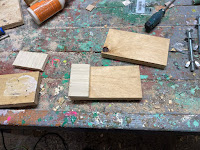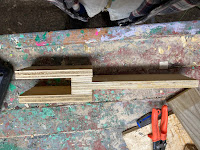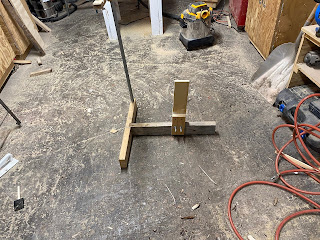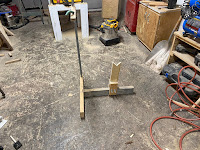The other day I got a bit of a brainwave on a project that involved a small gasoline engine and an old bicycle,
As luck should have it I happened to have a small gas engine and an old bike! However, like any good project, success lies in planning and preparation.
I realized that this project needed to have the bike up off the ground in order to make working on it a little easier and to prevent the bike from making an uncontrolled trip when I was testing the engine.
It was then a dim memory from my childhood sparked in the back of my brain...
Even as far back as elementary school, I was always a bit interested in tinkering. Often with very crude results.
One year, I got a subscription to Popular Mechanics for Christmas. Every month, for that year I got a nice little present in the mail and I spent hours going over the magazine from cover to cover.
I distinctly remember looking at all the woodworking and electronic projects that were highlighted, always feeling a bit glum that I didn't have the access to the neat tools needed to make those projects (Even if I did, I don't think anyone in their right mind would give a 12-year-old kid access to stationary power tools)
However, the woodworking gods smiled at me when the July 1980 issue arrived in my mailbox (yes, I know, I'm old).
The stand was the definition of simplicity, and well within the capability of a kid that had access to some scrap 2 X 4's and a hand saw.
After a few hours, I had built the stand and I had my bike upon it, ready for maintenance. Granted the stand didn't completely match the plans in the magazine, but it worked, and I was certainly pleased with my success.
I had completely forgotten about this until this exact moment and then it came back.
Of course, the magazine that I had been lost to time, but I didn't recall that Google Books had all the past issues of Popular Mechanics online and completely searchable.
So, when I plugged in "Bike Stand" in the search box, the plans popped up, exactly as I remembered it, 40 years ago (man, I really do feel old now)
Now that I found this treasure from my childhood, I got right into it.
I started by building the base for the stand.
First I cut out two 2 foot sections of 2X4 boards
The plans called for the base to be assembled as a T shape with one end of the 2X4 boards connecting in the middle of the other via a dado joint that has been cut into the middle of the second board.
To do that, I marked a 1.5-inch section in the middle of the board, then I set my table to a depth of a half-inch and made a series of cuts between the 2 lines that I had drawn on the board.
To complete the dado joint I then took a wood chisel and removed the little slivers of wood that I had remaining. The slivers can out with very little force, leaving a very clean slot that needed very little cleanup.
A quick test confirmed that I had a nice tight fit.
The stand uses a four-foot length of 7/8 inch conduit pipe to act as a support to an upper arm that will be used to hold the upper frame of the bike. This pipe is attached to the base of the stand via a 7/8 inch hole that this drilled into the end of the board that I had just cut the dado into.
The original plans called for a hole to be drilled into each end of the board with a slot cut into the ends of the board to allow for switching the support rod to either side of the base, with the idea of making the stand as flexible as possible to use.
For the sake of keeping it simple, and since I really just wanted something to hold the bike up, I elected to make the support rod a permanent installation on one side of the base. To do this, I just drilled a 7/8 inch hole at one end of the top of the T on the base.
Once the hole was drilled, I assembled the base of the stand by inserting one end of the 2X4 boards into the dado joint of the other and securing them in place with two 2.5 inch deck screws.
Next, I cut out a 4-foot length of 7/8 inch diameter metal conduit and attached it to the base by a friction fit.
The next step in the build was to make the upper support arm that will be used to hold the upper frame of the bike.
I started by cutting out a 14-inch length of 2X4. Looking at the plans, I noticed that the arm was cut to a width of 1.5 inches, tapering out to the full 3.5-inch width in order to allow for mounting to the support rod.
I sketched out the taper on the board as per the instructions and cut it to shape with the scroll saw.
With the basic wood parts created, I next focussed on the hardware for the stand.
The plans called for the top frame of the bike to be secured to the upper support arm of the stand with a 1/4 inch diameter, 3 inches long U bolt that was cut in half. This was easily done with some vice grips that had a cutting blade, but a hacksaw would have worked just as well too.
Once the bolt was cut, I then covered the U part of the bolt with a short length of rubber hose which will help protect the paint on the bike when it's secured to the stand.
Turning back to the upper support arm, I realized that I needed to make a few more alternations to it.
The first thing that needed to be done was to drill a hole at the "big" end of the arm to allow the support rod to run through the arm. To do this I measured into the middle of the thick part of the arm and drilled a 7/8 inch hole.
Since the arm needed to slide up and down the support rod in order match the size of whatever bike you are working on, the arm needed to be able to slide fairly easily up and down the rod and have the ability to be tightly secured in place on the rod when it's in the correct spot, I needed to add a slot to the end of the arm to allow for some expansion to slide on the rod, and the slot could be pinched together to secure it in place.
To make the slot, I set the blade of my table saw to a height so that it would cut through the hole that I just drilled. Next, I set the saw's fence to 3/4 inches and I made the slot by carefully running the support arm through the saw, end side down.
To do this, I cut a 1 inch deep "V" into the to of the arm a couple inches in from the smaller end of the arm.
Finally, I drilled a 1/4 inch hole through the slot I just cut and another 1/4 inch hole about an inch from the V groove
With all the holes drilled, I installed the U bolt and put a 2 inch long 1/4 inch bolt through the slot hole, and gave the arm a test fit on the support rod
The final thing to assemble was the mount for the pedals of the bike to sit on,
To build the mount, I first cut out a 14 X 3.5-inch length of 3/4 inch plywood, and two pieces of 7X3.5, and two 2X3.5 pieces of plywood.
I created a mount much like a sandwich, with the 14-inch piece of plywood being in the center with the 2 2 inch pieces on each side of the larger piece of wood, making sure that the bottom ends of all 3 parts are flush to each other.
Finally, I put the 7-inch pieces on top of the 2-inch pieces, making sure that the tops of those pieces were flush with each other.
The whole thing was then secured in place with 2.5-inch deck screws.
Next, I drilled two 3/8 inch holes 3 inches from the bottom of the mount.
I then put two 4 inch carriage bolts with wingnuts into the holes and gave the mount a test fit on the stand.
Tightening down the bolts secures the mount in place on the base.
Now that I was happy that the mount was in good shape, I finished it off by cutting out a 1.5 inch deep "V" in the top of the mount for the bike to sit in.
With that, the stand is finished, other than a coat of paint.
Mounting the bike in the stand is pretty simple, you sit the pedal axle into the V of the mount and you slide the bottom mound and the upper support arm until you have the bike in the location that you want.
When it is in position, you secure the bike in place by tightening down the bolts on the support arm and the bottom mounts.
Doing this project again brought back a lot of memories for me. The beauty of this project is that it can be made very cheaply and is an excellent and useful first project for kids!

















































No comments:
Post a Comment